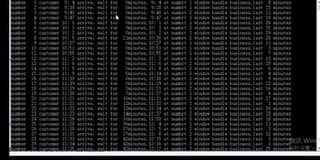Simulation of bank calling system Using linear list to simulate the bank's queuing business model 1) Suppose that the working hours of the bank are from 9 a.m. to 5 p.m 2) The time when customers arrive at the bank is generated randomly, and the customers are queued in the order of arrival. The time required for each customer to handle business can also be generated randomly, no more than 30 minutes. If the randomly generated time length is 0, it indicates that the customer leaves early and does not handle business. 3) When the program is running, input the number of bank windows, and then output the basic information of each customer's business in the bank according to the randomly generated customer data (arrival time, time required for business), including: customer arrival time, customer waiting time, what time the customer handled business in which window, and how long the business lasted. From this, we can observe the average waiting time of customers and the daily reception volume of banks when the number of windows is fixed. In the code below store all the information of the customers in linear data structure and the number of windows so that it can display like the attached picture not otherwise
Simulation of bank calling system
Using linear list to simulate the bank's queuing business model
In the code below store all the information of the customers in linear data structure and the number of windows so that it can display like the attached picture not otherwise
system//
#include <bits/stdc++.h>
using namespace std;
// this is the structure/class for customer
struct customer{
int ari_hr,ar_min,bt; // Arrival time-hrs:minutes, btMEANS bussiness time
//operator overloading of '<' (less than) operator
bool operator <(customer& c2){
if(ari_hr==c2.ari_hr)ar_min<c2.ar_min;
return ari_hr<c2.ari_hr;
}
};
int main(){
srand(time(0));
int wnum; //window numbers in bank
while(1){
cout<<"Please Enter the number of windows for the bank.\n";
cin>>wnum;
if(wnum<=0)break; // if wnum<=0 program will terminate
int n=1+rand()%100;
for(int i=0;i<n;++i){
qu[i].ari_hr=9+rand()%8;
qu[i].ar_min=rand()%60;
qu[i].bt=rand()%30;
}
sort(qu.begin(),qu.end()); //sorting the list accprding to their arrival time
/*
last[i] will store the time at which the last customer finishes work at window i+1
serve_cnt[i] will count the number of customer served at window i+1
*/
int last[wnum]={0},cust_num=0,serve_cnt[wnum]={0};
for(int i=0;i<n;++i) {
if(qu[i].bt==0)continue;
++cust_num;
int min_last=0; //store the window number which finishes earliest
for(int j=1;j<wnum;++j) {
if(last[j]<last[min_last])min_last=j;
}
++serve_cnt[min_last];
int wt=last[min_last]-qu[i].ari_hr*60-qu[i].ar_min; //waiting time calulation
wt=max(wt,0); //waiting cant be negative
last[min_last]=(qu[i].ari_hr*60+qu[i].ar_min+wt+qu[i].bt); // updating the last of the current window
//printing the output into the screen
cout<<"number "<<cust_num<<" customer "<<qu[i].ari_hr<<":"<<qu[i].ar_min<<" arrive,";
cout<<" wait for "<<wt<<"minutes, ";
int x=qu[i].ari_hr,y=qu[i].ar_min;
y+=wt;
x+=(y/60);
y%=60;
cout<<x<<":"<<y<<" at number "<<min_last+1<<" window handle bussiness,last "<<qu[i].bt<<" minutes.\n";
}
cout<<"No longer accept customer bussiness, ready to leave work\n\n";
for(int i=0;i<wnum;++i){
cout<<"number "<<i+1<<" window serve totally "<<serve_cnt[i]<<" customers.\n\n";
}
}
return 0;
}

Trending now
This is a popular solution!
Step by step
Solved in 4 steps with 1 images









